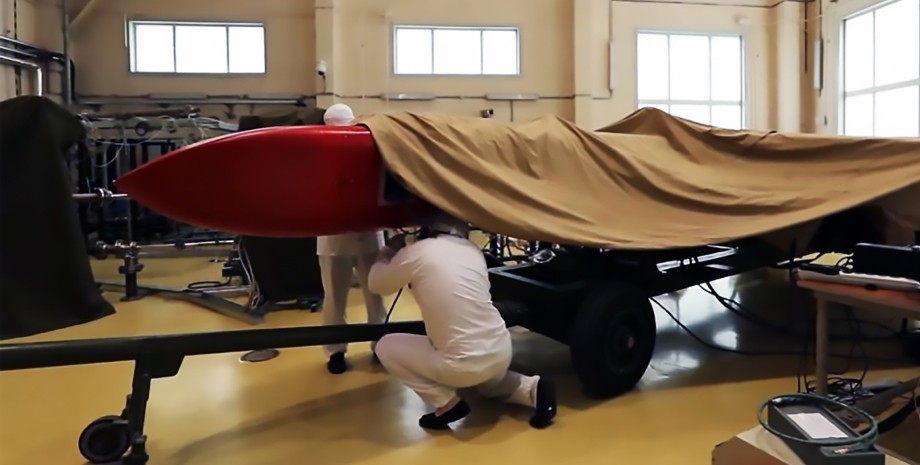
 By Natali Moss
By Natali Moss
In this regard, the focus gathered information on the latest development of Russian engineers and what threat is this type of weapons. The profile Russian resource "War Observation" told in detail about the new development under the name of 9m730 "Petrel" (NATO SSC-X-9 SkyFall), in the material of which the rocket was called "flying Chernobyl". If you believe the observers, the 9M730 product is created using unique technological solutions.
According to the available information, the rocket is equipped with a pulsating nuclear air-reactive engine (Puvavrd), which is unique in modern weapons. This involves the use of a small size zone, where graphite or more modern materials are probably used as a retarder, and atmospheric air is compacted as a coolant. Thus, the "brownish" is equipped with Pivavrdrd, not a direct nuclear engine (PVRD).
The main difference between these engines lies in the design: PuvRD has an air valve that prevents the reverse of the working body, whereas there is no valve in the PVRD, since the pressure at the entrance to the combustion chamber is created due to supersonic speeds. Meanwhile, this technological solution was criticized. Thus, in September 2023, the Vieces of The Insider published a material that called the Russian Petrel missile a myth that contradicts the school textbooks of physics.
The fact is that you can theoretically create a reactor that will produce sufficient thermal power due to the energy of several kilograms of high -enrichment uranium to create the desired traction for flight. However, such a reactor design and in general the rest of the rocket equipment, for example - the reactor and rocket control system, electricity generation system for onboard equipment - requires appropriate protection and massive cooling radiator, since the air flow may not be enough.
As a result, it increases the weight of the reactor to tens of tons and the dimensions of the rocket itself. But now it is known that the length of the product is at the time of start 12 m, during the flight - 9 m, and the nasal part has the shape of an ellipse 1 m by 1. 5 m. "In a word And another technique suitable for political bargaining, but not for war, " - sums up the publication.
Last year, The New York Times, citing a report to the Nuclear Threat Initiative Analytical Organization, released material that 13m730 rocket tests were conducted in Russia in the 2017-2019, which all ended. During one test launch, the rocket was able to fly 35 km before falling into the sea, otherwise the rocket engine did not start. The characteristics and purpose of this system were also reported.
For example, the flight range is allegedly 3000 km (according to the International Institute for Strategic Studies - up to 20,000 km), and the rocket itself is designed to strike a secondary nuclear stroke after the use of intercontinental ballistic nuclear missiles. Although theoretically, as noted by British Lieutenant General Jim Gukenhall, the rocket design makes it possible to stay in the air unlimited time.
Another important aspect is the threat of pollution of the products of the nuclear reactor of the rocket, as evidenced by the report of the Russian authorities about the "temporary dangerous zone" off the coast of the Barents Sea, where they were tested by the "storm". Moreover, the presence of a radioactive trace is a factor in detection of ammunition, which can affect the effectiveness of its use.
So the aircraft of a long radar detection can be fixed, and detect the flight zone of the winged rocket. And given that the rocket has a flow rate of 900 km / h, it is vulnerable to modern air defense systems. But in Russian sources it is reported that among the radioactive elements that can be detected are isotopes of iodine-131, ruthenium-103, cesium-134 and cesium-137.
However, even this method has its restrictions: radioactive particles absorb the atmosphere only on the third or fourth day after launch, which makes early detection almost impossible. On the other hand, as noted by French military expert Koranten Brustlen, the presence of a power plant will allow the use of trajectories that the enemy does not monitor, break the missile defense and accordingly strike the low -protected objects.
"In a complicated world military-political situation, it will become a very serious trump card," the expert emphasized. The report of the National Air and Space Intelligence of the US Air Force states that the presence in the Russian Federation "Petrel" will allow her to have a unique weapon with intercontinental flight range in the arsenal. Among other stated characteristics, the rocket has a fairly low flight height-in the area of 50-100 meters.
It is much lower than the height of the winged rocket with a conventional engine, which complicates its detection even by modern air defense radars. In addition, the 9M730 rocket is equipped with a 2 megaton combat unit, making it an extremely powerful weapon. Due to the virtually unlimited flight range and the ability to move during air traffic, the rocket can be a challenge to global international security.
We summarize, based on the information of both Western and Russian sources, innovative development of engineers from the Russian Federation really threatens, but only if the military managed to conduct successful tests Moscow nuclear triad.










All rights reserved IN-Ukraine.info - 2022